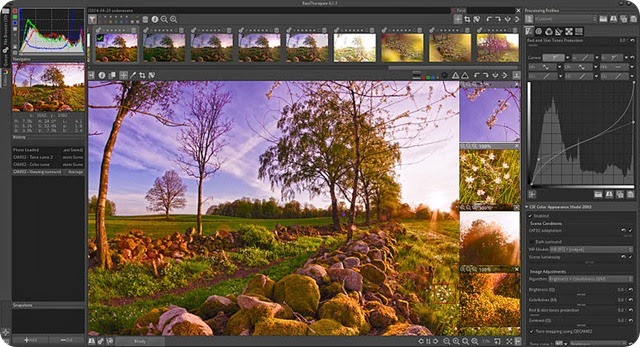RawTherapee is a cross-platform raw image processing program, released under the GNU General Public License Version 3.
It was originally written by Gábor Horváth of Budapest, Hungary, before being re-licensed as free and open-source software in January 2010.
It is written in C++, using a GTK+ front-end and a patched version of dcraw for reading raw files. It is notable for the advanced control it gives the user over the demosaicing and developing process.
The name used to stand for "The Experimental Raw Photo Editor"; however that acronym has been dropped, and RawTherapee is now a full name in itself.
RawTherapee comprises a subset of image editing operations specifically aimed at non-destructive raw photo post-production and is primarily focused on improving a photographer's workflow by facilitating the handling of large numbers of images.
RawTherapee involves the concept of non-destructive editing, similar to that of some other raw conversion software. Adjustments made by the user are immediately reflected in the preview image, though they are not physically applied to the opened image but the parameters are saved to a separate sidecar file. These adjustments are then applied during the export process.
Input file formats.
RawTherapee can work with both raw files from digital cameras and usual images. It also supports high dynamic range, 16/24/32-bit raw DNG images.
While reading raw files it relies on the dcraw code, but only for parsing formats, not for processing. Thus, RawTherapee supports all the formats supported by dcraw.
Additionally, RawTherapee supports the following image formats:
JPEG
TIFF
PNG
User interface.
RawTherapee provides the user with a file browser, a queue, and an image editing tab.
The file browser shows photo thumbnails along with a caption of the shooting information metadata. The browser includes 5-star rating, flagging, and an Exif-based filter. It can be used to apply a profile, or parts of a profile, to a whole selection of photos in one operation.
The queue tab allows one to put exporting photos on hold until done adjusting them in the Editor, so that CPU is fully available to the user while tweaking a photo, instead of processing photos while the user is trying to tweak new ones which could result in a sluggish interface. Alternatively, it can be used to process photos alongside tweaking new ones, if one has a CPU capable of handling the workload.
The Editor tab is where the user tweaks photos. While the image is opened for editing, the user is provided with a preview window with pan and zoom capabilities. A color histogram is also present offering linear and logarithmic scales, and separate R, G, B and L channels. All adjustments are reflected in the history queue and the user can revert any of the changes at any time. There is also the possibility of taking multiple snapshots of the history queue, allowing for various versions of the image being shown. These snapshots are not written to the sidecar file and are subsequently lost once the photo has been closed, however work is underway on migrating the PP3 sidecar system to XMP which already supports storing snapshots.
Adjustment tools and processing.
Demosaicing. User can choose from AMaZE, IGV, LLMSE, EAHD, HPHD, VNG4, DCB, AHD, fast and bilinear algorithms. Latest 4.1 development versions also handle Fujifilm X-Trans files.
Processing profiles support with the ability to load, save and copy profiles between images.
Exposure control allowing manipulation of exposure compensation, brightness, highlight recovery, shadow recovery, brightness, contrast and saturation.
Advanced highlight reconstruction algorithms and shadow/highlight controls.
RGB and Lab curves
Various methods of sharpening
Various methods of noise reduction
Detail recovery
White balance (presets, color temperature, spot white balance and auto white balance)
Channel mixer
Color boost and vibrance (saturation control with the option of preserving natural skin tones)
Hue, saturation and value adjustments using curves
Tone mapping using edge-preserving decomposition
ICC color profiles (input, working and output)
DCP color profiles (input)
Adobe Lens Correction Profiles (LCP)
Crop
Resize
Rotation with visual straightening tool
Distortion correction
Perspective adjustment
Manual and automatic chromatic aberration correction
Vignetting correction with adjustable center offset
Dark frame subtraction
Flat field removal (hue shifts, dust removal, vignetting correction)
Hot and dead pixel filter
Metadata (Exif and IPTC) editor
Processing queue
Output formats.
Output format can be selected from:
TIFF (8-bit, 16-bit and 32-bit)
JPEG (8-bit)
PNG (8-bit and 16-bit)
If you liked this article, subscribe to the feed by clicking the image below to keep informed about new contents of the blog:









0 commenti:
Post a Comment